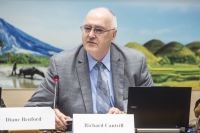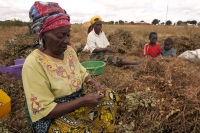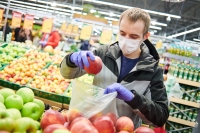News
.jpg)
15/03/2021
Dietary data reveal important information about food safety as well as nutrition. FAO and WHO are working together to make information available about what people eat and drink reportedly so that governments can estimate dietary exposure to chemical and biological hazards and nutrient intake. The FAO/WHO Global Individual Food Consumption Data Tool (GIFT) collates and shares individual food consumption data that comes from national and sub-national surveys conducted in different parts of the world. The FAO/WHO GIFT is an open access repository of quantitative sex-and-age disaggregated data, which contribute to the assessment of food safety...

10/03/2021
Richard Cantrill is a food safety and quality consultant with expertise in edible fats and oils and is based in Halifax, Nova Scotia, Canada. He was formerly the Chief Scientific Officer and Technical Director of the American Oil Chemists’ Society. Dr Cantrill was vice-chairperson for the 89th and 90th sessions of the Joint FAO/WHO Expert Committee on Food Additives (JECFA) and chairperson for the 91st, which concluded on 25 February 2021, when the meeting report was adopted.
The meeting chaired by Cantrill evaluated cadmium and ergot alkaloids, and discussed the acceptability of certain substances as previous cargoes as well as the...

23/02/2021
Within Maasai pastoralist communities, milk provides a rich source of nutrients and income, especially for women, and plays a central role in cultural and religious ceremonies. Having milk means having livestock, and having livestock means the continuation of the Maasai people. While a vital nutritional and cultural resource, milk is also a potential food safety risk as well as a vehicle for the transmission of antimicrobial resistance (AMR).
This risk occurs as some Maasai do not boil their milk or observe withdrawal - the period of time necessary for antimicrobial residues to degrade - after administering drugs to their livestock. By...

22/02/2021
The government of Malawi has signed a new Technical Cooperation Project (TCP) with FAO to strengthen the national food control system in Malawi that will run until the end of 2022. The TCP builds on the results of a participatory assessment of the national food control system (NFCS) that was implemented in Malawi in 2017-2018, using the FAO/WHO food control system assessment tool.
Malawi is a country whose economy is largely agro-based with agriculture contributing to about 42 percent of the national gross domestic product (GDP) and 81 percent of export earnings (source: MoAIWD, 2018). The national agricultural and...

14/02/2021
Watch as this year’s World Food Safety Day theme and visual identity are unveiled in an online event on 18 February 2021. A newscast-style video will shine a spotlight on food safety efforts – at government level, within food and agriculture production and in particular in communicating with the public and sharing food safety-related information.
The line-up includes stories from FAO, WHO and the secretariats of the Codex Alimentarius Commission and International Food Safety Authorities Network.
Tune in on:
Date: 18 February 2021 Time: 15:00 CET (UTC+1) Platform: https://twitter.com/FAOWHOCodex (no Twitter account needed to watch the video)
In case you...

27/01/2021
A virtual meeting of the Joint FAO/WHO Expert Meetings on Microbiological Risk Assessment (JEMRA) of Listeria monocytogenes in Ready-To-Eat (RTE) Food: Attribution, Characterization and Monitoring was held from 20 October to 6 November 2020. The purpose of the meeting was to review recent data on Listeria monocytogenes and determine the need to modify, update or develop new risk assessment models and tools for this pathogen.
Prior to the meeting, a public call for data and experts was issued. In addition, background documents were prepared ahead of time for consultation by the experts. The documents included:
A review of two...

15/01/2021
Two FAO and WHO directors briefed the Executive Committee of the Codex Alimentarius Commission (CCEXEC) yesterday on the UN Food Systems Summit, which UN Secretary-General António Guterres will convene later in 2021 to set about bold new actions that transform the way the world produces and consumes food. Jamie Morrison, FAO Director of the Food Systems and Food Safety Division and Lead on Knowledge and Policy for the Food Systems Summit Secretariat, and Francesco Branca, WHO Director of Nutrition and Food Safety, emphasized the important role food safety and Codex standards will have in the transformation process, and can benefit food...

16/12/2020
The 90th Joint FAO/WHO Expert Committee on Food Additives (JECFA) met from 26 October to 6 November 2020 to carry out risk assessments of trichothecenes (T-2 and HT-2) and discuss the acceptability of certain substances used as previous cargoes.
The meeting saw the participation of a number of prominent international scientists with a wide range of expertise. While initially slated to be held at the WHO headquarters in Geneva, the meeting instead took place on a virtual platform due to the various pandemic-related restrictions in place.
Trichothecenes are toxins produced by fungi that grow on many different grains like wheat, oats, and...

09/12/2020
A Joint FAO/WHO Expert Meeting was convened virtually on 30 March–3 April 2020 to provide risk assessments for tropane alkaloids, hyoscyamine and scopolamine. These occur in several plants that can contaminate staples like cereals and grains through the presence of toxic Datura stramonium seeds. Food aid contaminated with tropane alkaloids was determined to be the cause of food poisoning outbreaks in the Republic of Uganda and the Republic of South Sudan in 2019. These events affected more than 300 people and even resulted in deaths.
There are currently no international regulations in place for tropane alkaloids. With global distribution of...

09/12/2020
In October 2020, FAO released a guidance document to help decision-makers rank the public health risks posed by foodborne hazards and/or foods in their countries. The focus was on microbial and chemical hazards in foods but the approach explained in the guide could be used for any hazard. The guidance document walks readers through three iterative steps (defining the scope, developing the approach and conducting the risk ranking analysis and reporting results) to calculate the likelihood and severity of the adverse impact that foodborne hazards could have on the health of a target population.
We spoke with Dr Barbara Kowalcyk,...
Stay up to date and connect to our RSS feed!
